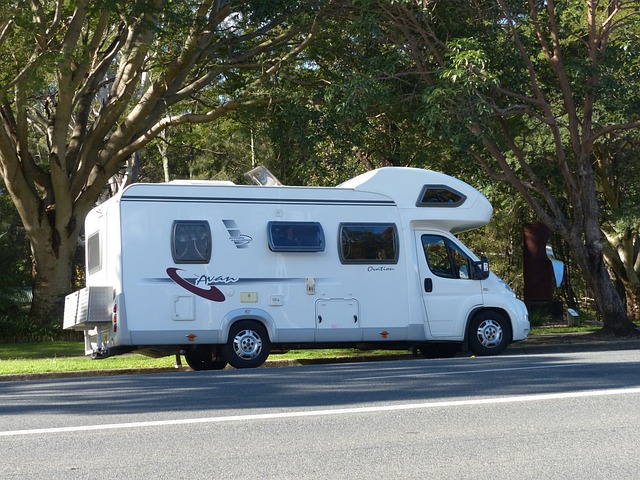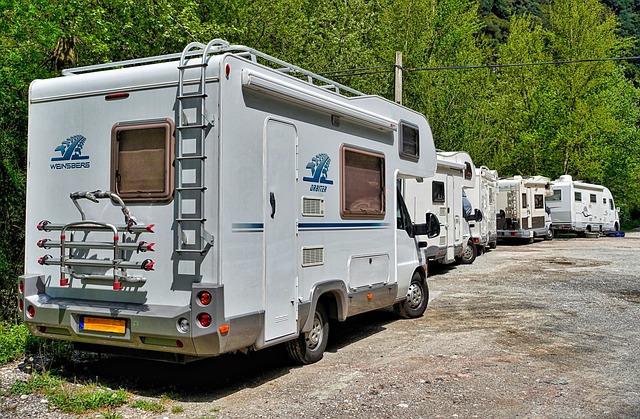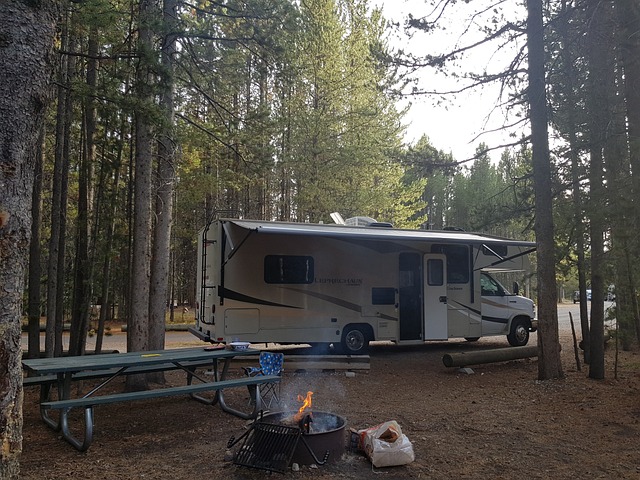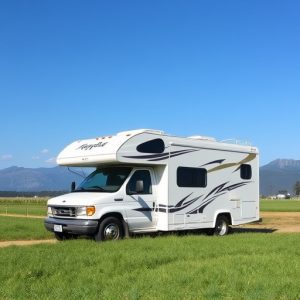Mastering RV Weight Limits for Safe Towing: A Comprehensive Guide to RV Travel Tips
Before hitting the road with your RV, it's essential to understand the weight classifications …….

Before hitting the road with your RV, it's essential to understand the weight classifications and capacity limits for safe travel. The Unladen Vehicle Weight (UVW) is the starting point, indicating the RV's empty weight. Add the Gross Vehicle Weight Rating (GVWR), which includes everything inside, and you have the maximum safe operating weight. Exceeding this can be hazardous. The Gross Combination Weight Rating (GCWR) must also be observed, as it's the total weight of both the RV and tow vehicle including cargo. Adhering to these ratings ensures optimal tire health, suspension function, and overall safety. Proper load distribution according to UVW and GVWR is crucial for handling, fuel efficiency, and avoiding wear on components and systems. Always consult your RV manual, use scales, and follow RV Travel Tips to stay within legal weight limits and manufacturer guidelines. Safe towing depends on this foundational knowledge, which also extends to understanding axle weight ratings to prevent mechanical issues or accidents. By carefully packing with a low center of gravity, utilizing tie-downs, and considering additional weights from passengers and purchases, you can ensure your RV journey is lawful, efficient, and enjoyable. Remember to use digital scales for accurate weight measurements and follow a detailed checklist that includes all your travel gear to guarantee a secure and compliant trip. Adhering to these RV travel tips is key to navigating with confidence and making the most of your adventure.
Embarking on an RV journey offers unparalleled freedom and adventure. However, to tow your home-on-wheels safely, it’s crucial to grasp the nuances of RV weight limits. This article demystifies the different weight classifications, clarifying the distinctions between Unladen Vehicle Weight (UVW) and Gross Vehicle Weight Rating (GVWR). We’ll delve into the significance of Axle Weight Ratings and offer strategic load distribution tips to enhance safety and efficiency. With RV Travel Tips infused throughout, you’ll be equipped with an essential checklist to ensure compliance before hitting the road. Safely navigate your RV adventures with confidence, knowing you’re within the safest weight parameters.
- Decoding the Different Weight Classifications of RVs for Safe Towing
- Understanding Unladen Vehicle Weight vs. Gross Vehicle Weight Rating (GVWR)
- The Importance of Axle Weight Ratings and How They Impact Your RV Journey
- Strategies for Load Distribution in RV: Maximizing Safety and Efficiency
- Essential Checklist Before Hitting the Road with Your RV: Ensuring Compliance with Weight Limits
Decoding the Different Weight Classifications of RVs for Safe Towing

When planning to tow an RV, understanding the different weight classifications is crucial for a safe and efficient journey. RVs are categorized into various weight classes that dictate the type of vehicle you need for towing, as well as compliance with legal requirements and adherence to safety standards. The first classification to consider is the Gross Vehicle Weight Rating (GVWR), which denotes the maximum loaded weight of the RV, including all contents and accessories. Knowing your GVWR ensures that your vehicle isn’t overburdened, which can affect handling and increase the risk of accidents.
The next important classification is the Gross Combination Weight Rating (GCWR), which is the maximum combined weight of the towed RV and the towing vehicle when combined for travel. This includes the weight of both vehicles, the cargo they’re carrying, and any fluids. The GCWR is a critical figure because it informs you about the limits beyond which the stability and safety of your convoy could be compromised. To tow an RV safely, you must also consider the Gross Axle Weight Rating (GAWR), which is the maximum weight that each axle of the RV should carry. Proper distribution of weight across the axles is vital for maintaining control and preventing tire damage or suspension issues.
Understanding these weight classifications and adhering to them through careful packing and selecting the right tow vehicle are essential RV travel tips for ensuring a secure and enjoyable trip. Always refer to your RV’s manual, check local laws regarding vehicle weights, and use scales if necessary to accurately measure and stay within these limits. Safe towing begins with understanding these classifications and applying them effectively.
Understanding Unladen Vehicle Weight vs. Gross Vehicle Weight Rating (GVWR)

When planning an RV adventure, it’s crucial to familiarize yourself with the various weight ratings associated with your vehicle. One of the key distinctions is between the Unladen Vehicle Weight (UVW) and the Gross Vehicle Weight Rating (GVWR). The UVW, also known as curb weight or dry weight, represents the mass of the RV without any occupants, cargo, fluids, or optional equipment. This figure allows you to understand the base weight of your RV and is essential when considering what additional weight will be added by your personal belongings, food supplies, and even the water in the tank.
On the other hand, the GVWR encompasses the UVW plus the weight of all contents, passengers, cargo, and any additional equipment. It’s the maximum loaded weight that your RV can safely operate. Exceeding this limit can compromise safety and put you at risk of fines or vehicle damage. Understanding and adhering to these weight limits is not just about compliance; it’s a cornerstone of RV travel tips for ensuring a safe and enjoyable journey. Properly loaded RVs handle better, have better fuel efficiency, and are less prone to mechanical issues. Therefore, always refer to your RV’s manual for accurate UVW and GVWR figures and use RV travel tips as guidance to balance your load effectively. This diligence not only enhances safety but also maximizes the performance and longevity of your RV.
The Importance of Axle Weight Ratings and How They Impact Your RV Journey

When embarking on an RV journey, understanding the axle weight ratings is paramount to ensure safety and compliance with road regulations. These ratings denote the maximum weight that each axle of a vehicle can safely carry, including the weight of the RV, cargo, and passengers. Adhering to these limits prevents excessive stress on the axles, which could lead to mechanical failures, such as bent axles or tire blowouts. Properly distributing weight across the RV’s axles is not only a legal requirement but also critical for maintaining optimal handling and braking performance. Overloading an axle can result in uneven wear of the tires and suspension components, potentially leading to costly repairs or even accidents. To navigate the roads confidently and safely, RV travelers should meticulously calculate their load distribution, considering both stationary weight and dynamic weight during movement. This process involves strategically packing the RV to keep heavy items low and over the axles, and ensuring that the total weight doesn’t exceed the sum of the individual axle ratings. By respecting these limits, RVers can enhance their travel experience, maintain their vehicle’s integrity, and uphold road safety for everyone. Keeping abreast of RV weight distribution laws and regulations is essential, as they can vary by state or country, and understanding the concept of gross vehicle weight rating (GVWR) in relation to axle weight ratings is a key part of responsible RV travel.
Strategies for Load Distribution in RV: Maximizing Safety and Efficiency

When it comes to safely towing an RV, understanding and properly distributing its weight is paramount for both the longevity of your vehicle and the safety of all occupants on the road. Proper load distribution not only adheres to legal weight limits but also enhances the handling and stability of the RV. To achieve this, it’s essential to categorize the cargo into two groups: essential items for travel and non-essential supplies. The essentials should be packed first and placed in a manner that maintains a low center of gravity. Heavier items like propane tanks and batteries should be positioned close to the floor and evenly across the RV to prevent any one area from becoming too heavy. Additionally, using RV Travel Tips such as securing the cargo with tie-downs or straps can prevent shifting during transit, which can cause unsafe weight shifts.
For those RVers with cargo that exceeds the interior capacity, it’s crucial to utilize external storage solutions and consider the weight these additions contribute to the overall load. External compartments should be packed tightly to minimize movement and maximize efficiency. It’s also wise to invest in a digital scale to accurately weigh your RV with all intended contents before hitting the road. This step cannot be overstated, as it ensures compliance with weight limits set forth by both state regulations and the RV manufacturer. By carefully considering load distribution and employing these RV Travel Tips, you can enhance your RV’s performance and extend its operational lifespan, making every journey a safe and enjoyable one.
Essential Checklist Before Hitting the Road with Your RV: Ensuring Compliance with Weight Limits

When embarking on an RV travel adventure, it’s imperative to meticulously prepare for the journey to ensure safety and compliance with weight limits. An essential checklist should be followed to guarantee a smooth and secure travel experience. The first step is to familiarize yourself with the vehicle’s dry weight, gross vehicle weight rating (GVWR), and gross combination weight rating (GCWR). These figures are crucial for understanding the maximum safe weight your RV can carry. Verify the weights of your RV when fully prepped for travel, including all contents, to avoid exceeding these limits. Proper loading is also vital; ensure that the cargo is evenly distributed and not concentrated in one area, which could alter the vehicle’s handling and stability.
In addition to understanding your RV’s weight capacity, it’s important to account for additional factors that affect load distribution and safety. This includes the weight of all passengers, any trailers or toads (towable vehicles), and personal belongings. Don’t forget to include the potential weight of supplies you plan to acquire during your trip. Utilize a digital scale to accurately measure the weight of items as they are added to the RV. By adhering to these RV travel tips, you can confidently navigate with peace of mind, knowing that you and your vehicle are within the safe weight limits, ready for the open road ahead.
When embarking on RV travel adventures, adhering to weight limits is paramount for a safe and enjoyable journey. This article has demystified the various weight classifications of RVs, differentiating between Unladen Vehicle Weight and Gross Vehicle Weight Rating (GVWR). It has also highlighted the significance of Axle Weight Ratings in maintaining the integrity of your RV’s structure and performance on the road. By implementing effective load distribution strategies, you can optimize safety and efficiency. Remember to consult the provided checklist before departing, ensuring that your rig complies with the necessary weight restrictions. With these RV travel tips in mind, you can confidently navigate the open road, making each trip a secure and satisfying experience.







